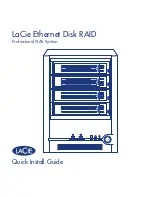
PDS Series User Manual ( V1.4, Oct. 2009) ----- 178
7.
IP (Internet Protocol) address
Every interface on an Internet must have a unique IP address (also called an Internet
address). These addresses are 32-bit numbers. They are normally written as four
decimal numbers, one for each byte of the address such as “192.168.41.1”. This is
called dotted-decimal notation.
8.
MAC (Media Access Control) address
To allow a computer to determine which packets are meant for it, each computer
attached to an Ethernet is assigned a 48-bit integer known as its MAC address (also
called an Ethernet address, hardware address or physical address). They are normally
written as eight hexadecimal numbers such as “00:71:88:af:12:3e:0f:01”. Ethernet
hardware manufacturers purchase blocks of MAC addresses and assign them in
sequence as they manufacture the Ethernet interface hardware. Thus, no two hardware
interfaces have the same MAC address.
9.
Subnet Mask
Subnet mask is often simply called the mask. Given its own IP address and its subnet
mask, a host can determine if a TCP/IP packet is destined for a host that is (1) on its
own subnet, or (2) on a different network. If (1), the packet will be delivered directly;
otherwise if, will be delivered via gateways or routers.
10.
ARP (Address Resolution Protocol)
Consider two machines A and B that share a physical network. Each has an assigned
IP address IP
A
and IP
B
, and a MAC address the MAC
A
and MAC
B
. The goal is to
devise low-level software that hides MAC addresses and allows higher-level programs
to work only with the IP addresses. Ultimately, however, communication must be
carried out by the physical networks using whatever MAC address scheme the
hardware supplies.
Suppose machine A wants to send a packet to machine B across a physical network to
which they are both attached, but A only has the Internet address for B, IP
B
. The
question arises: how does A map that address to the MAC address for B, MAC
B
?
ARP provides a method of dynamically mapping 32-bit IP address to the
corresponding 48-bit MAC address. The term dynamic is used since it happens
automatically and is normally not a concern for either the application user or the
system administrator.
Summary of Contents for PDS-700 Series
Page 56: ...PDS Series User Manual V1 4 Oct 2009 56 PDSM 782 D PPDSM 782 D Pin Assignments...
Page 58: ...PDS Series User Manual V1 4 Oct 2009 58 PDS 700 IP67...
Page 59: ...PDS Series User Manual V1 4 Oct 2009 59...
Page 60: ...PDS Series User Manual V1 4 Oct 2009 60...
Page 61: ...PDS Series User Manual V1 4 Oct 2009 61 DS 712 PPDS 712 MTCP Pin Assignments E1 10 100 Base TX...
Page 62: ...PDS Series User Manual V1 4 Oct 2009 62 DS 715 PPDS 715 MTCP Pin Assignments E1 10 100 Base TX...
Page 64: ...PDS Series User Manual V1 4 Oct 2009 64 Digital Output...
Page 66: ...PDS Series User Manual V1 4 Oct 2009 66 PDSM 700 PPDSM 700 MTCP...
Page 67: ...PDS Series User Manual V1 4 Oct 2009 67 PPDS 700 IP67...
Page 68: ...PDS Series User Manual V1 4 Oct 2009 68...
Page 69: ...PDS Series User Manual V1 4 Oct 2009 69 Din Rail Mounting Stack Mounting...
Page 91: ...PDS Series User Manual V1 4 Oct 2009 91...
Page 147: ...147 Init Mode Short INIT and GND PDSM 700 D PPDSM 700 D MTCP Run Mode Open INIT...
Page 152: ...PDS Series User Manual V1 4 Oct 2009 152 Example...














































